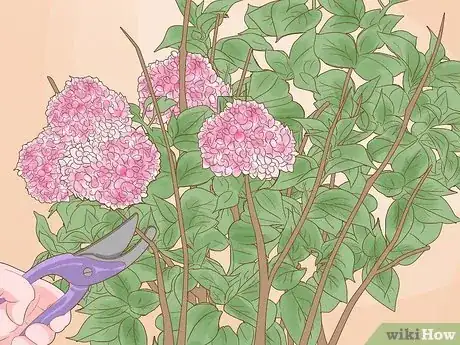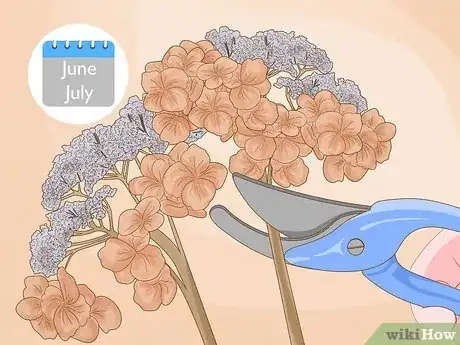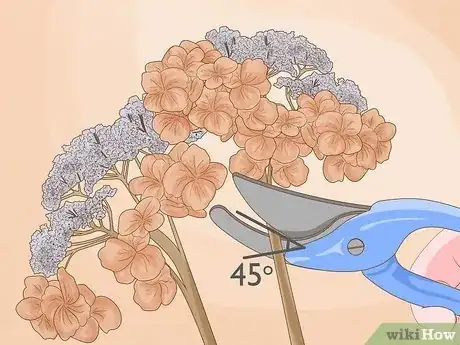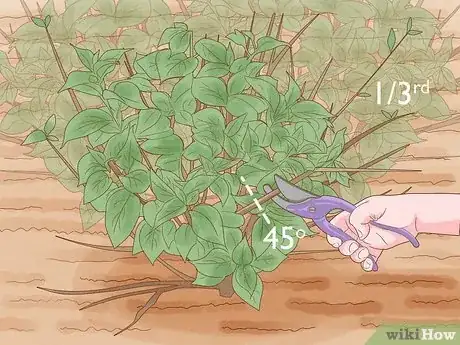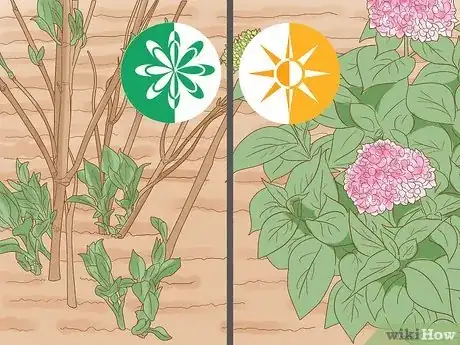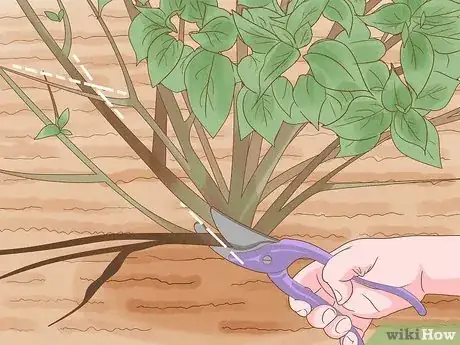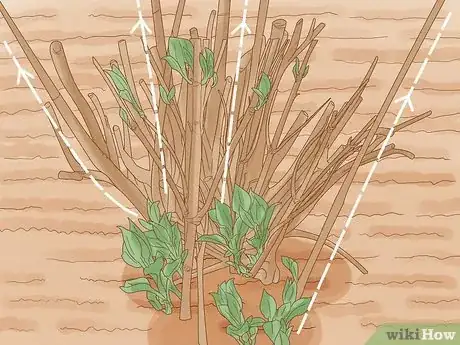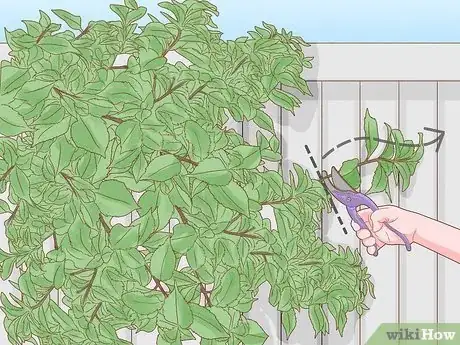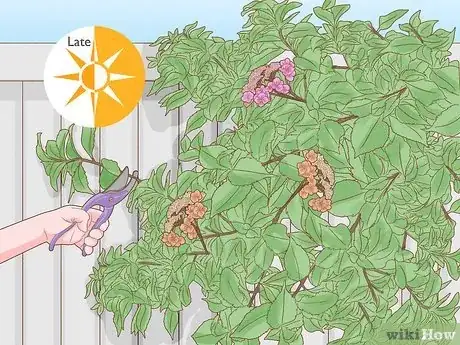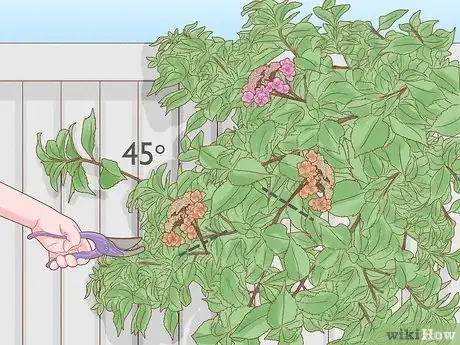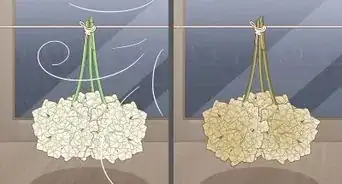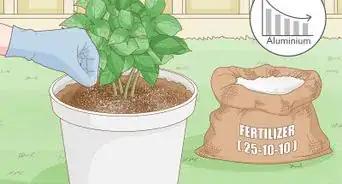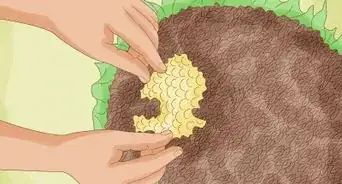This article was co-authored by Maggie Moran and by wikiHow staff writer, Savannah Vold. Maggie Moran is a Professional Gardener in Pennsylvania.
wikiHow marks an article as reader-approved once it receives enough positive feedback. This article received 19 testimonials and 100% of readers who voted found it helpful, earning it our reader-approved status.
This article has been viewed 820,728 times.
Nothing says class like gorgeous, well-manicured hydrangeas proudly displayed throughout your garden. Pruning hydrangeas can help them retain a uniform shape and keep them healthy so that they produce beautiful blooms year after year. Not all hydrangeas are pruned at the same time, so it's important to know what variety you have before you go outside with those pruning shears—if you prune your hydrangea at the wrong time of year, you could cut into next season's blooms. In this article, we’ll teach you all about how best to prune your blooms for healthy, happy hydrangeas!
Things You Should Know
- Prune your hydrangea at a 45-degree angle with clippers or pruning shears during mid-summer months to avoid accidentally cutting off any new growth.
- Remove old blooms just under the heads at the tip of the stem and dead or crossed canes to increase airflow and promote new growth.
- Prune your hydrangea that's grown too big for your liking in June or July by cutting back the branches by 1/3 to the nearest joint.
Steps
Hydrangeas that Bloom on Old Wood
-
1Check if your hydrangea blooms on old wood by inspecting it for buds. Some hydrangeas will bloom from last year’s growth, also called “old wood.” Inspect your existing hydrangea canes for bud growth when they become visible in late spring/early summer before clipping any canes away. Hydrangeas with this characteristic tend to bloom in early summer, and the flowers die by mid-summer. At this point, the shrub begins producing the buds that will bloom the following year.[1] Hydrangeas that bloom on old wood include the following:
- Bigleaf, Mopleaf or Lacecap hydrangeas (Hydrangea macrophylla and H. serrata)
- Oakleaf hydrangeas (H. quercifolia)
- Reference https://www.gardenia.net/compare-plants/hydrangeas to help you identify what kind of hydrangea you have before planning to prune your plant.
-
2Prune just after the blooming peak in June or July. Since these types of hydrangeas start producing buds soon after blooming, in late summer and early fall, it's essential to prune them as it begins to fade in mid-summer. If you've missed this window, just wait until next year to prune the hydrangea. Hydrangeas don't have to be pruned yearly, so waiting won't be a problem.[2]
- If you're unhappy with your hydrangea's shape, you can go ahead and prune–just know that in doing so outside of the short midsummer window, you'll risk hurting its appearance next spring.
Advertisement -
3Remove old blooms at a 45-degree angle. Right after they're spent, use sharp pair of clippers or pruning shears to deadhead the blooms. Do so by cutting off dead flower heads at a 45-degree angle at the top of the stem, just under the old bloom. This way, you can trim the shrub before it begins to produce the buds that will turn into next year's flowers. The longer you wait, the likelier it will be that you'll cut off some of next year's growth.[3]
- You can also remove dead or dying canes at this time; trim them at their base.
-
4Remove the oldest canes with loppers. When a hydrangea is several years old, it will produce fewer blooms. You can promote new growth by removing some of the older canes—up to 1/3 of them. For thicker canes, you may need loppers to cut them. Cut these older canes to the ground at a 45-degree angle.[4]
-
5Prune the hydrangea to reduce its size if desired, or leave it as-is. If your hydrangea has grown quite large, you can prune it in June or July (just after the blooming season) to contain it a bit. At a 45-degree angle, trim back the branches by 1/3 to the nearest joint. In most cases, hydrangeas will grow back quite quickly, so you may not be able to maintain the smaller size for long.[5]
- This type of pruning isn't necessary for the plant's health. Only do it if your hydrangea is taking up too much space. When planting new hydrangeas, it's best to choose a spot where they can grow freely.
- "Endless Summer" hydrangeas are an exception to the rule. This variety is more low-maintenance than others and can really be pruned at any season—there is no "bad time."
- Endless Summer hydrangeas can mainly be left alone until they mature. You can then "deadhead" the plant in the spring or fall to encourage new flowers.
Hydrangeas that Bloom on New Wood
-
1Check if your hydrangea blooms on new wood by looking for growth. These hydrangea varieties produce new growth each spring, then bloom from that growth later in the summer. This new growth will appear as fresh, green canes being pushed out from the soil, unlike hydrangeas that grow on old wood, which present as buds on existing branches. Hydrangeas that bloom on new wood tend to bloom later than hydrangeas that bloom on old wood since they need extra time to create buds.[6] The following varieties bloom on new wood:
- Panicle hydrangeas (H. paniculata), such as PeeGee or Limelight. These can be pruned into a tree form to make it a focal point of the garden.[7]
- Smooth hydrangeas (H. arborescens), such as Annabelle
- Use the images at https://www.gardenia.net/compare-plants/hydrangeas to help you identify what kind of hydrangea you have before planning to prune your plant.
-
2Prune in late winter before bud generation begins. Since these varieties produce their blooms on new stems, you want to prune them in the winter before they start growing to get your hydrangeas to bloom to their fullest capacity. This is the best time of year to prune new wood varieties, but you can also prune them at other times of the year—just avoid pruning them right before they bloom in the spring and early summer.[8]
- You can cut back all the stems by 1/3 in the winter. Pruning at this time will help the shrub produce bigger, showier flowers.
- However, many gardeners like their hydrangeas to have smaller flowers on sturdier stems. If this is your preference, do your pruning in the fall instead to allow the plants to grow strong branches before blooming.
-
3Clip off dead blooms at a 45-degree angle under its base. Dead blooms will usually be a faded brown and look significantly drier than blooms that aren’t at the end of their life cycle. To prune, simply locate the base of your bloom at the top of the stem, and clip them off at a 45-degree angle. Don’t forget to use a sharp pair of clippers or pruning shears to help you get the job done right.[9]
- If you’ve chosen to prune in winter, trim back all the branches by 1/3 to the nearest joint. Make sure to maintain a 45-degree angle with your clippers.
-
4Prune dead canes and crossed branches. Use hand shears or loppers to remove dead canes and crossed or tangled branches. Pruning dead branches and canes will free up the plant and allow for better airflow, encouraging it to grow stronger. Remember to cut back no more than 1/3 of the hydrangea's total canes so the strength and structure of the plant are maintained, and it doesn't die off.[10]
-
5Leave some old growth to support the plant to help it to grow well. Hydrangea flowers tend to be on the heavy side, so don't go overboard pruning old canes. Leave a good network of canes intact so that the branches don't flop over under the weight of the flowers.[11]
- Another great way to encourage growth is to fertilize your hydrangea bush in early spring to help those little blooms reach their maximum potential.
Climbing Hydrangeas
-
1Cut your climbing hydrangea back if it's unruly. Climbing hydrangea (“Hydrangea Petiolaris”) is a gorgeous hydrangea variety with vine-like capabilities and can grow up and around wherever it's planted. While it's not necessary to prune your climbing hydrangeas, it’s totally fine to trim them back if it’s become a little unruly.[12]
-
2Prune your climbing hydrangea in late summer. Climbing hydrangeas typically bloom in late spring and can continue until mid-summer. To avoid cutting into any new growth during pruning, it’s best to cut back your climbing hydrangea in the late summer months, like July or August.[13]
-
3Remove faded flower heads by cutting them off under the dead bloom. Cut your hydrangea canes at a 45-degree angle directly underneath the dead bloom. Remember to use a sharp pair of clippers or pruning shears to keep your lovely climbing hydrangea looking trim and shapely. [14]
-
4Remove dead and excess canes to fit your desired space. If you’re pruning your climbing hydrangea to fit a specific space, like clipping it back from a window on the side of your house, simply cut excess and dead canes at a 45-degree angle about 1/3 of the way down the cane. Use your pruning shears to clip back as much of your hydrangea as necessary to achieve your desired look.[15]
- Just remember that the rule of thumb is not to cut more than 1/3 of the way down the cane unless you have to clear an area entirely. In that case, you can cut further down the cane as needed or all the way down to the ground.
Expert Q&A
-
QuestionWhy are my hydrangeas not blooming?
 Maggie MoranMaggie Moran is a Professional Gardener in Pennsylvania.
Maggie MoranMaggie Moran is a Professional Gardener in Pennsylvania.
Home & Garden Specialist Sometimes, hydrangeas won't bloom because the old wood is dying back. It can also be caused by pruning at the wrong time and cutting off new growth.
Sometimes, hydrangeas won't bloom because the old wood is dying back. It can also be caused by pruning at the wrong time and cutting off new growth. -
QuestionAre you supposed to deadhead hydrangeas?
 Maggie MoranMaggie Moran is a Professional Gardener in Pennsylvania.
Maggie MoranMaggie Moran is a Professional Gardener in Pennsylvania.
Home & Garden Specialist Yes, you can deadhead hydrangeas. It mainly depends on what time of year it is.
Yes, you can deadhead hydrangeas. It mainly depends on what time of year it is. -
QuestionDo I have to prune my hydrangeas?
 Maggie MoranMaggie Moran is a Professional Gardener in Pennsylvania.
Maggie MoranMaggie Moran is a Professional Gardener in Pennsylvania.
Home & Garden Specialist No, you don't have to prune them, unless you feel the shrub is too large and takes up too much space.
No, you don't have to prune them, unless you feel the shrub is too large and takes up too much space.
References
- ↑ https://extension.illinois.edu/blogs/good-growing/2022-03-10-how-properly-prune-hydrangeas
- ↑ http://www.finegardening.com/how-to/articles/how-to-prune-hydrangeas.aspx
- ↑ https://extension.illinois.edu/blogs/good-growing/2022-03-10-how-properly-prune-hydrangeas
- ↑ https://www.allaboutgardening.com/prune-hydrangeas/
- ↑ http://www.hydrangeashydrangeas.com/pruning.html
- ↑ https://extension.illinois.edu/blogs/good-growing/2022-03-10-how-properly-prune-hydrangeas
- ↑ https://www.thisoldhouse.com/gardening/reviews/limelight-hydrangea-trees
- ↑ https://extension.illinois.edu/blogs/good-growing/2022-03-10-how-properly-prune-hydrangeas
- ↑ https://www.allaboutgardening.com/prune-hydrangeas/
- ↑ https://www.allaboutgardening.com/prune-hydrangeas/
- ↑ https://www.allaboutgardening.com/prune-hydrangeas/
- ↑ https://www.sundaygardener.co.uk/climbing-hydrangea.html
- ↑ https://www.sundaygardener.co.uk/climbing-hydrangea.html
- ↑ https://www.sundaygardener.co.uk/climbing-hydrangea.html
- ↑ https://www.allaboutgardening.com/prune-hydrangeas/
About This Article
Before pruning your hydrangeas, look online to identify what kind of hydrangea you have so you can determine whether it blooms on old or new wood. For example, species like Lacecap hydrangeas bloom on old wood, while Limelight and Annabelle hydrangeas bloom on new wood. For shrubs that bloom on old wood, prune off the flowers as soon as they start to fade in mid-summer and trim older stems at the base to promote new growth. If you have a shrub that blooms on new wood, cut back the stems by 1/3 in late winter and remove any dead canes. For tips from our Horticultural reviewer on how to prune your hydrangea for a sturdier plant with smaller flowers, read on!
